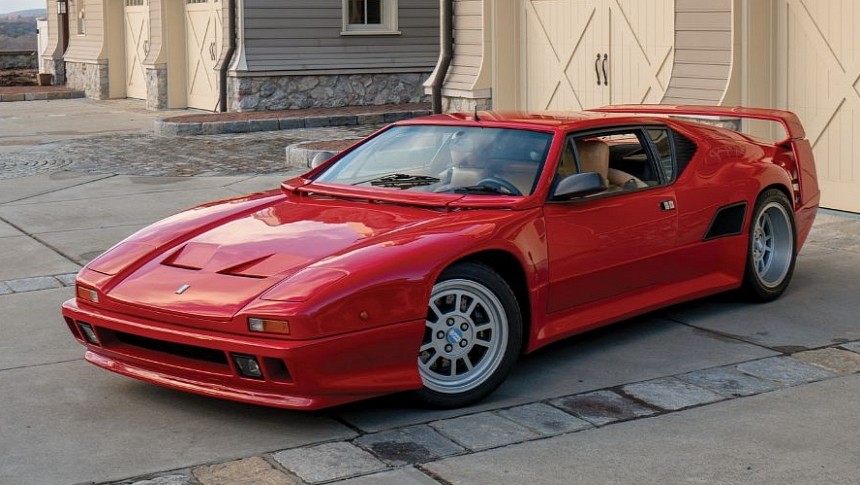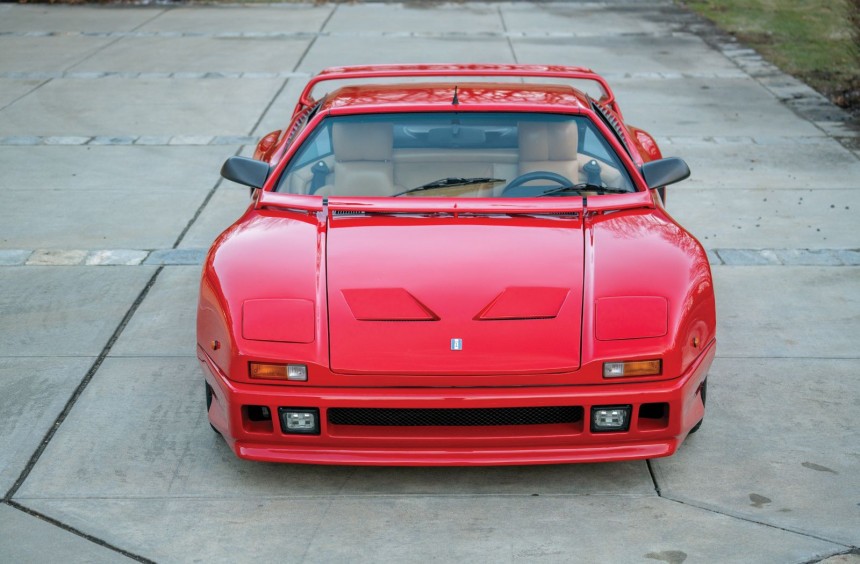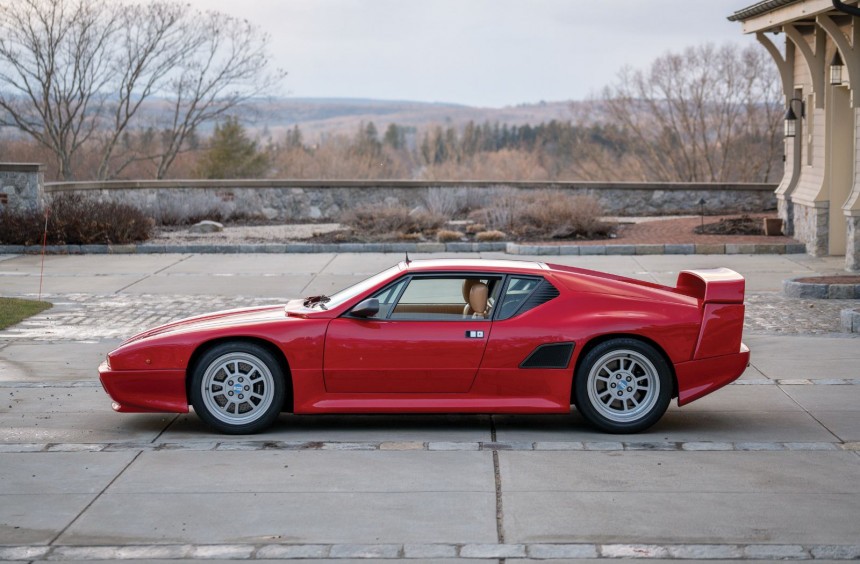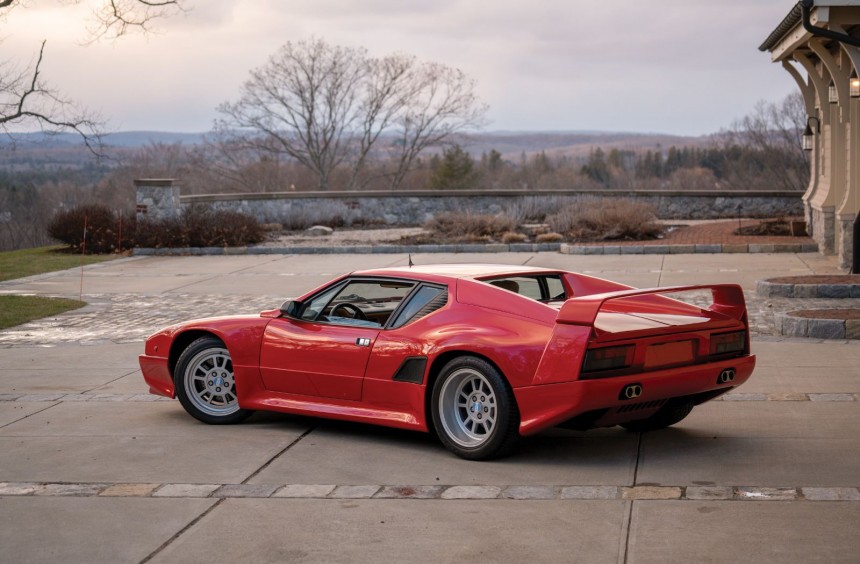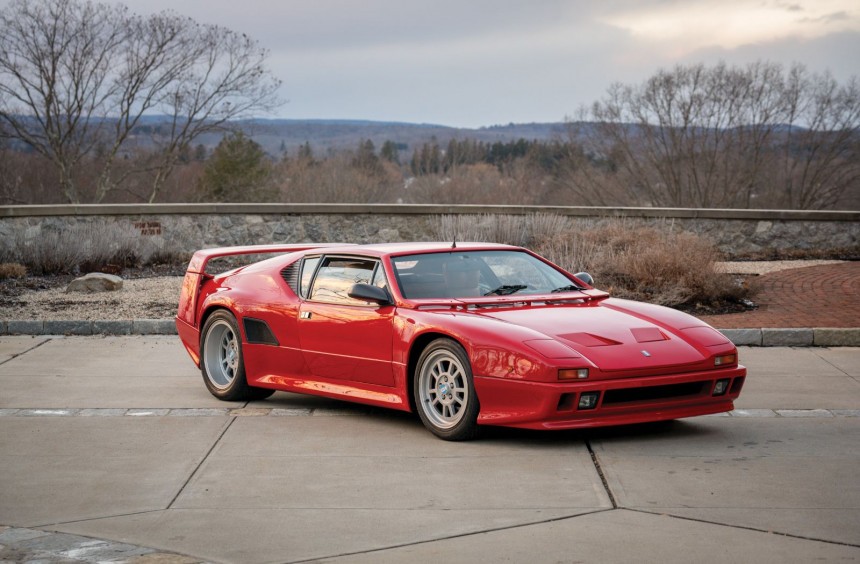The most famous and successful Italian mid-engine machine that didn't feature Ferrari or Lamborghini badges, the Pantera was produced from 1971 to 1993. Its last iteration, dubbed 90 Si, became a spectacular, entry-level supercar that's still incredibly cool today.
The story of De Tomaso starts in 1959 in Modena, the Italian city that would become the supercar capital of the world. Founded by Argentine-born Alejandro de Tomaso with financial backing from successful American businessman and brother-in-law Amory Haskell Jr., the company initially developed race cars, but from 1963 onwards, it shifted its focus to road-legal sports cars.
The first production model was a small, mid-engine coupe called Vallelunga which helped increase the company's popularity and earned it a commission from Carroll Shelby for the development of a Can-Am race car. But, due to De Tomaso's inability to deliver the car in time for the 1965 Can-Am season, Shelby canceled the contract, and the project morphed into a road-legal sports car meant to spite the legendary American engineer.
Named Mangusta (mongoose in Italian), after the small carnivorous mammal renowned for its ability to kill the venomous cobra, the mid-engine, Ford V8-powered machine was never the Shelby Cobra-killer envisioned by Alejandro de Tomaso, but it laid the groundwork for the company's most successful model.
The Pantera (panther in Italian), a thoroughly improved successor for the Mangusta, was unveiled back home in Modena in 1970, and a few months later, it took to the stage at the New York Motor Show. It was acclaimed by both the general public and the automotive press, becoming De Tomaso's most successful model in the following years.
The Italian carmaker had a fruitful collaboration with Ford, who had supplied the powertrains for all of its production models, including the new Pantera.
The Blue Oval was desperate to become the first American manufacturer to market a mid-engine sports car domestically. After failing to purchase Ferrari a few years later, it struck a deal with Alejandro de Tomaso and purchased an 80% stake in his company. Consequently, the Pantera was sold in the US through Ford's Lincoln-Mercury dealership network.
Of the 7,260 Panteras produced from 1971 to 1993, around 5,500 were sold on American soil in just four years. But, due to disagreements with the Italians and the effects of the 1973 energy crisis, Ford stopped importing the Pantera after the 1975 model year. Subsequently, the corporation sold the controlling stake back to Alejandro de Tomaso for a fraction of the initial price, which enabled the Italian company to continue developing the Pantera.
Though it never officially returned to the US, the model continuously improved over the next decade and became a better, more-luxurious, limited-edition sports car that sold relatively well in Europe.
By the late 1980s, the Pantera – still heavily based on the initial 1970s design – was becoming obsolete. But, rather than discontinuing the model, De Tomaso hired prominent Italian designer Marcello Gandini who helped thoroughly redesign it. The finished product, which became the last iteration of the Pantera, was codenamed 90 Si, and unlike the initial 1970s version, it crossed the line into modern supercar territory.
Introduced in 1990, the Pantera 90 Si was built around an extensively modified version of the original steel monocoque chassis. The structure received a lighter, more rigid tubular rear subframe that supported the powertrain and a new Brembo braking system shared with the Ferrari F40.
Additionally, the suspension gained longer arms at the front and shorter ones at the rear. Coupled with beefier anti-roll bars and new adjustable shocks, the revamped suspension drastically improved handling. The 90 Si became much more stable through tight corners, which addressed the most significant issue that plagued previous versions.
For the bodywork, Marcello Gandini took Tom Tjaarda's original design to a different level. Redesigning almost every panel, the stylist who made a name for himself by sketching the Lambo Miura, Countach, and Diablo prototype thoroughly modernized the Pantera without ruining any of the distinctive cues that made the original design special.
Apart from the wider fenders, side skirts, or the redesigned engine cover and front lid, the new Pantera's most striking features were the F40-style rear spoiler and the aerofoil located at the base of the windscreen – a Gandini aerodynamic trademark.
Though the previous GT5 and GT5 S Panteras also received extensive bodywork upgrades, the 90 Si looked like a new, modern supercar rather than a 1970s sports car upgraded with a body kit.
Even though Ford sold its stake in De Tomaso in 1975, it continued supplying engines to the Italian company.
The early Pantera was equipped with a 351-ci (5.8-liter) Windsor V8, but after the engine was discontinued in 1972, the car received the newer four-bolt main Cleveland V8 with a Cobra Jet cam.
Though in its most potent form, it made 345 hp, the carburated Cleveland was considered obsolete in the late 1980s. As a matter of fact, it was discontinued in the US way back in 1974, and the Australian version that De Tomaso used was also retired in 1982. The remaining batch of engines was shipped to Italy in the following years, continuing to power the Pantera until 1988.
For the 90 Si, the company decided to continue using a Ford unit which was cheaper and more reliable than other available alternatives. The chosen engine became the High Output (HO) 302-ci (4.9-liter) small block found in the Fox-body Mustang GT. Better known as "the 5.0", the V8 was rated at 225 hp and 300 lb-ft (406 Nm) of torque.
However, De Tomaso engineers upgraded it with a new camshaft, cylinder heads, valvetrains, intake manifolds, and higher-compression pistons. With these new components, the engine could easily reach 400 hp, but due to stringent emission regulations, a catalytic converter had to be added, and output was restricted to 305 hp. In terms of torque, 333 lb-ft (451 Nm) was sent to the rear wheels through a five-speed manual transaxle equipped with a limited-slip differential.
The new engine enabled the Pantera 90 Si to print from 0 to 62 mph (100 kph) in 5.4 seconds and reach a top speed of 165 mph (265 kph).
Though it was less powerful and about a second slower from 0 to 62 mph (100 kph) than the Ferrari F40 or Lamborghini Diablo, the 90 Si was also much more affordable. With a price tag of around $80,000 ($185,685 today), it was five times cheaper than an F40 and three times cheaper than the Diablo.
The balance between performance and cost made it the perfect limited-edition, entry-level supercar, yet the financial turmoil of the early 1990s severely impacted sales.
Until 1994 when the last Pantera left the factory, the company only managed to build 41 out of the projected 75 units. Out of those, two were crash tested, and one was sent to the De Tomaso museum, so only 38 examples were delivered to customers.
Today, the De Tomaso Pantera Si 90 is a very sought-after collector's item. Examples rarely show up at auctions, but when they do, the average value exceeds the $200,000 mark. The red car featured in this article was auctioned off by RM Sotheby's in 2019, fetching $240,800.
Three decades after it rode into the sunset, the Pantera Si 90 is a somewhat affordable 1990s supercar that looks and sounds amazing, as you can see (and hear) in the YouTube video below by franz krum.
Although it wasn't the most powerful, it remains the best-performing and most beautiful iteration of the iconic Pantera lineage.
The first production model was a small, mid-engine coupe called Vallelunga which helped increase the company's popularity and earned it a commission from Carroll Shelby for the development of a Can-Am race car. But, due to De Tomaso's inability to deliver the car in time for the 1965 Can-Am season, Shelby canceled the contract, and the project morphed into a road-legal sports car meant to spite the legendary American engineer.
Named Mangusta (mongoose in Italian), after the small carnivorous mammal renowned for its ability to kill the venomous cobra, the mid-engine, Ford V8-powered machine was never the Shelby Cobra-killer envisioned by Alejandro de Tomaso, but it laid the groundwork for the company's most successful model.
The Pantera (panther in Italian), a thoroughly improved successor for the Mangusta, was unveiled back home in Modena in 1970, and a few months later, it took to the stage at the New York Motor Show. It was acclaimed by both the general public and the automotive press, becoming De Tomaso's most successful model in the following years.
The last, most breathtaking evolution of the iconic Pantera
The Blue Oval was desperate to become the first American manufacturer to market a mid-engine sports car domestically. After failing to purchase Ferrari a few years later, it struck a deal with Alejandro de Tomaso and purchased an 80% stake in his company. Consequently, the Pantera was sold in the US through Ford's Lincoln-Mercury dealership network.
Of the 7,260 Panteras produced from 1971 to 1993, around 5,500 were sold on American soil in just four years. But, due to disagreements with the Italians and the effects of the 1973 energy crisis, Ford stopped importing the Pantera after the 1975 model year. Subsequently, the corporation sold the controlling stake back to Alejandro de Tomaso for a fraction of the initial price, which enabled the Italian company to continue developing the Pantera.
Though it never officially returned to the US, the model continuously improved over the next decade and became a better, more-luxurious, limited-edition sports car that sold relatively well in Europe.
By the late 1980s, the Pantera – still heavily based on the initial 1970s design – was becoming obsolete. But, rather than discontinuing the model, De Tomaso hired prominent Italian designer Marcello Gandini who helped thoroughly redesign it. The finished product, which became the last iteration of the Pantera, was codenamed 90 Si, and unlike the initial 1970s version, it crossed the line into modern supercar territory.
Comprehensive chassis and body improvements
Additionally, the suspension gained longer arms at the front and shorter ones at the rear. Coupled with beefier anti-roll bars and new adjustable shocks, the revamped suspension drastically improved handling. The 90 Si became much more stable through tight corners, which addressed the most significant issue that plagued previous versions.
For the bodywork, Marcello Gandini took Tom Tjaarda's original design to a different level. Redesigning almost every panel, the stylist who made a name for himself by sketching the Lambo Miura, Countach, and Diablo prototype thoroughly modernized the Pantera without ruining any of the distinctive cues that made the original design special.
Apart from the wider fenders, side skirts, or the redesigned engine cover and front lid, the new Pantera's most striking features were the F40-style rear spoiler and the aerofoil located at the base of the windscreen – a Gandini aerodynamic trademark.
Though the previous GT5 and GT5 S Panteras also received extensive bodywork upgrades, the 90 Si looked like a new, modern supercar rather than a 1970s sports car upgraded with a body kit.
A Fox-body Mustang heart
The early Pantera was equipped with a 351-ci (5.8-liter) Windsor V8, but after the engine was discontinued in 1972, the car received the newer four-bolt main Cleveland V8 with a Cobra Jet cam.
Though in its most potent form, it made 345 hp, the carburated Cleveland was considered obsolete in the late 1980s. As a matter of fact, it was discontinued in the US way back in 1974, and the Australian version that De Tomaso used was also retired in 1982. The remaining batch of engines was shipped to Italy in the following years, continuing to power the Pantera until 1988.
For the 90 Si, the company decided to continue using a Ford unit which was cheaper and more reliable than other available alternatives. The chosen engine became the High Output (HO) 302-ci (4.9-liter) small block found in the Fox-body Mustang GT. Better known as "the 5.0", the V8 was rated at 225 hp and 300 lb-ft (406 Nm) of torque.
However, De Tomaso engineers upgraded it with a new camshaft, cylinder heads, valvetrains, intake manifolds, and higher-compression pistons. With these new components, the engine could easily reach 400 hp, but due to stringent emission regulations, a catalytic converter had to be added, and output was restricted to 305 hp. In terms of torque, 333 lb-ft (451 Nm) was sent to the rear wheels through a five-speed manual transaxle equipped with a limited-slip differential.
The new engine enabled the Pantera 90 Si to print from 0 to 62 mph (100 kph) in 5.4 seconds and reach a top speed of 165 mph (265 kph).
It wasn't a marketing success, despite its attractive price tag
The balance between performance and cost made it the perfect limited-edition, entry-level supercar, yet the financial turmoil of the early 1990s severely impacted sales.
Until 1994 when the last Pantera left the factory, the company only managed to build 41 out of the projected 75 units. Out of those, two were crash tested, and one was sent to the De Tomaso museum, so only 38 examples were delivered to customers.
Today, the De Tomaso Pantera Si 90 is a very sought-after collector's item. Examples rarely show up at auctions, but when they do, the average value exceeds the $200,000 mark. The red car featured in this article was auctioned off by RM Sotheby's in 2019, fetching $240,800.
Three decades after it rode into the sunset, the Pantera Si 90 is a somewhat affordable 1990s supercar that looks and sounds amazing, as you can see (and hear) in the YouTube video below by franz krum.
Although it wasn't the most powerful, it remains the best-performing and most beautiful iteration of the iconic Pantera lineage.
